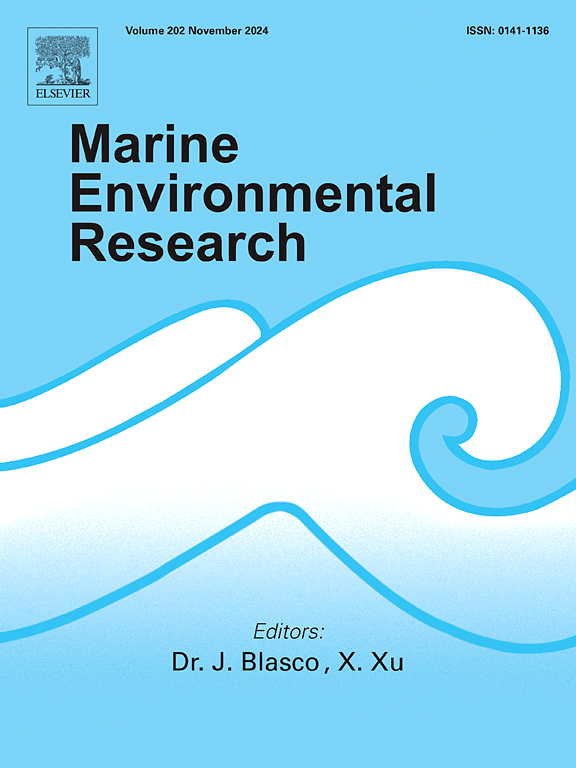基于物理化学变量的热带太平洋东部海景分类
IF 3
3区 环境科学与生态学
Q2 ENVIRONMENTAL SCIENCES
引用次数: 0
摘要
东热带太平洋(ETP)是一个高度环境异质性的海洋,具有高度的生物丰富度和地方性。通过对海景进行分类来捕捉和构建这种可变性对于支持生态研究和基于生态系统的海洋管理至关重要。本文基于20年来的卫星和模式数据,利用7个基本气候变量(ecv),包括海面温度、盐度、pH、浊度和流速,对ETP进行了客观的海景分类。我们比较了四种无监督聚类方法、三种模糊c均值(FCM)算法和自组织地图结合介质周围划分(SOM-PAM)对ETP海景的分类。因此,ETP被分别分为13个和15个海景。SOM-PAM方法提供了更精细的空间分辨率和更多的生态可解释模式,因此被选择用于最终分类。15幅海景(SS)描绘了一致的环境结构,包括高盐度和高热变异性(SS-1 - SS-3);外围受副热带水团影响(SS-4、SS-14);以强流速为主(SS-12, SS-13);以热稳定性(SS-7-SS-10)为特征;过渡条件(SS-5、SS-6、SS-11);与淡水输入有关的低盐度(SS-15)。该分类反映了关键的海洋学特征,其中一些海景与现有的生物地理框架在空间上是一致的。此外,分析还揭示了以前未被认识的海景,这些海景代表了ETP内重要的海洋学过程。这一分类为理解空间明确的环境框架提供了一步,为ETP的海洋空间规划、生物多样性研究和生态进化过程评估提供了信息。本文章由计算机程序翻译,如有差异,请以英文原文为准。

Classifying the seascape of eastern tropical pacific based on physicochemical variables
The Eastern Tropical Pacific (ETP) is a highly environmentally heterogeneous ocean with high biological richness and endemism. Capturing and structuring this variability through a classification into seascapes is essential to support ecological research and ecosystem-based marine management. Here, we present an objective seascape classification for the ETP based on 20 years of satellite- and model-derived data using seven Essential Climate Variables (ECVs), including sea surface temperature, salinity, pH, turbidity, and current velocity. We compared four unsupervised clustering methods, three Fuzzy c-means (FCM) algorithms and Self-Organizing Maps combined with Partitioning Around Medoids (SOM-PAM) to classify the ETP seascape. As a result, the ETP was divided into thirteen and fifteen seascapes, respectively. The SOM-PAM approach provided finer spatial resolution and more ecologically interpretable patterns and was thus selected for the final classification. The fifteen seascapes (SS) delineated consistent environmental structures, including those with high salinity and thermal variability (SS-1–SS-3); peripheral ones influenced by subtropical water masses (SS-4, SS-14); dominated by strong current velocities (SS-12, SS-13); characterized by thermal stability (SS-7–SS-10); transitional conditions (SS-5, SS-6, SS-11); and low salinity associated with freshwater input (SS-15). The classification reflects key oceanographic features with several seascapes showing spatial congruence with existing biogeographic frameworks. Additionally, the analysis revealed previously unrecognized seascapes that represent important oceanographic processes within the ETP. This classification offers a step forward for the understanding of the spatially explicit environmental framework to inform marine spatial planning, biodiversity studies, and assessments of eco-evolutionary processes in the ETP.
求助全文
通过发布文献求助,成功后即可免费获取论文全文。
去求助
来源期刊

Marine environmental research
环境科学-毒理学
CiteScore
5.90
自引率
3.00%
发文量
217
审稿时长
46 days
期刊介绍:
Marine Environmental Research publishes original research papers on chemical, physical, and biological interactions in the oceans and coastal waters. The journal serves as a forum for new information on biology, chemistry, and toxicology and syntheses that advance understanding of marine environmental processes.
Submission of multidisciplinary studies is encouraged. Studies that utilize experimental approaches to clarify the roles of anthropogenic and natural causes of changes in marine ecosystems are especially welcome, as are those studies that represent new developments of a theoretical or conceptual aspect of marine science. All papers published in this journal are reviewed by qualified peers prior to acceptance and publication. Examples of topics considered to be appropriate for the journal include, but are not limited to, the following:
– The extent, persistence, and consequences of change and the recovery from such change in natural marine systems
– The biochemical, physiological, and ecological consequences of contaminants to marine organisms and ecosystems
– The biogeochemistry of naturally occurring and anthropogenic substances
– Models that describe and predict the above processes
– Monitoring studies, to the extent that their results provide new information on functional processes
– Methodological papers describing improved quantitative techniques for the marine sciences.
 求助内容:
求助内容: 应助结果提醒方式:
应助结果提醒方式:


